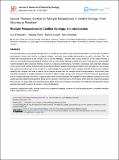Files in this item
Multiple perspectives in conflict settings : an introduction
Item metadata
| dc.contributor.author | Elcheroth, Guy | |
| dc.contributor.author | Penic, Sandra | |
| dc.contributor.author | Usoof, Ramila | |
| dc.contributor.author | Reicher, Steve | |
| dc.date.accessioned | 2020-01-14T13:30:04Z | |
| dc.date.available | 2020-01-14T13:30:04Z | |
| dc.date.issued | 2019-12-18 | |
| dc.identifier | 265730441 | |
| dc.identifier | 8d8d1825-c5d3-4e88-9cdf-d56cc9cc83ff | |
| dc.identifier | 85077204772 | |
| dc.identifier | 000514932600010 | |
| dc.identifier.citation | Elcheroth , G , Penic , S , Usoof , R & Reicher , S 2019 , ' Multiple perspectives in conflict settings : an introduction ' , Journal of Social and Political Psychology , vol. 7 , no. 2 , pp. 913-924 . https://doi.org/10.5964/jspp.v7i2.1333 | en |
| dc.identifier.issn | 2195-3325 | |
| dc.identifier.other | Bibtex: JSPP1333 | |
| dc.identifier.uri | https://hdl.handle.net/10023/19276 | |
| dc.description | The drafting of this paper, the editing of the special thematic session, and the research programme that provided a key impetus for both, were financially supported by the Swiss National Science Foundation (r4d – Swiss Programme for Research on Global Issues for Development, Pluralistic Memories Project, SNSF grant numbers: 400240_146955 / 400240_171188). | en |
| dc.description.abstract | In this introduction to the special thematic section, we discuss the pre-eminent research orientation in the social and political psychology of peace and conflict, its current critiques, and what more multiple perspectives can add to the field. First, we outline key characteristics of the ‘simple road’ to conflict settings: a simple, often binary, definition of the sides involved, a focus on one conflict-induced negative outcome and on one causal pathway leading to it, and a motivation to derive policy recommendations from empirical findings. Second, we discuss constructivist, normative, ecological, and pragmatic critiques of the ‘simple road’, as four distinct strands grounded in different epistemological assumptions, but converging on the account that research priorities need to be revised and methodologies be expanded. Third, engaging with the fundamental questions raised by the critiques, we make a plea for more multiple perspectives: for multiple voices among research participants (more diversified samples), for multiple positions from where to listen to these voices (more time-points and multi-factorial approaches), and for multiple sensors with which to capture them (more mixed methods). We highlight how the different contributions to the section provide creative developments along one or several of the three axes. On the basis of the concrete inspiring examples they provide, we argue that a field growing along these axes would increase its capacity to bridge its most important critical developments and to expand its scope in relevant directions. | |
| dc.format.extent | 369296 | |
| dc.language.iso | eng | |
| dc.relation.ispartof | Journal of Social and Political Psychology | en |
| dc.subject | Peace and conflict studies | en |
| dc.subject | Parsimonious research designs | en |
| dc.subject | Complexity | en |
| dc.subject | Multiple perspectives | en |
| dc.subject | Diversified samples | en |
| dc.subject | Holistic approaches | en |
| dc.subject | Mixed methods | en |
| dc.subject | BF Psychology | en |
| dc.subject | T-NDAS | en |
| dc.subject.lcc | BF | en |
| dc.title | Multiple perspectives in conflict settings : an introduction | en |
| dc.type | Journal article | en |
| dc.contributor.institution | University of St Andrews. Centre for Research into Equality, Diversity & Inclusion | en |
| dc.contributor.institution | University of St Andrews. St Andrews Sustainability Institute | en |
| dc.contributor.institution | University of St Andrews. School of Psychology and Neuroscience | en |
| dc.identifier.doi | 10.5964/jspp.v7i2.1333 | |
| dc.description.status | Peer reviewed | en |
This item appears in the following Collection(s)
Items in the St Andrews Research Repository are protected by copyright, with all rights reserved, unless otherwise indicated.

